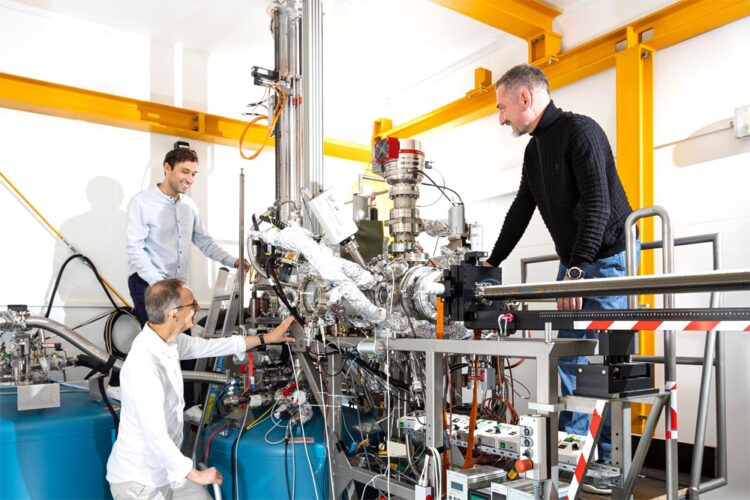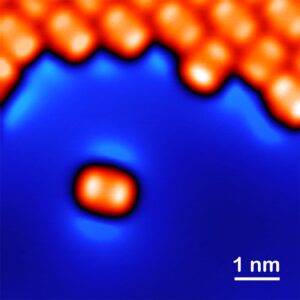Quantum microscope made in Jülich

Prof. Stefan Tautz (left below), Dr Taner Esat (left above) and Prof. Ruslan Temirov (right) at the Jülich quantum microscope.
Copyright:
Forschungszentrum Jülich / Sascha Kreklau
Physicists at Forschungszentrum Jülich have developed a unique scanning tunnelling microscope with magnetic cooling to study quantum effects.

Copyright: Forschungszentrum Jülich / Taner Esat, Ruslan Temirov
Scanning tunnelling microscopes capture images of materials with atomic precision and can be used to manipulate individual molecules or atoms. Researchers have been using the instruments for many years to explore the world of nanoscopic phenomena. A new approach by physicists at Forschungszentrum Jülich is now creating new possibilities for using the devices to study quantum effects. Thanks to magnetic cooling, their scanning tunnelling microscope works without any moving parts and is almost vibration-free at extremely low temperatures as low as 30 millikelvin. The instrument can help researchers unlock the exceptional properties of quantum materials, which are crucial for the development of quantum computers and sensors.
Physicists consider the temperature range near absolute zero to be a particularly exciting area for research. Thermal fluctuations are reduced to a minimum. The laws of quantum physics come into play and reveal special properties of materials. Electric current then flows freely without any resistance. Another example is a phenomenon called superfluidity: Individual atoms fuse into a collective state and move past each other without friction.
These extremely low temperatures are also required to research and harness quantum effects for quantum computing. Researchers worldwide as well as at Forschungszentrum Jülich are currently pursuing this goal at full speed. Quantum computers could be far superior to conventional supercomputers for certain tasks. However, development is still in its infancy. A key challenge is finding materials and processes that make complex architectures with stable quantum bits possible.
“I believe a versatile microscope like ours is the tool of choice for this fascinating task, because it enables matter to be visualized and manipulated at the level of individual atoms and molecules in many different ways,” explains Ruslan Temirov from Forschungszentrum Jülich.
Over years of work, he and his team have equipped a scanning tunnelling microscope with magnetic cooling for this purpose. “Our new microscope differs from all the others in a similar way to how an electric car differs from a vehicle with a combustion engine,” explains the Jülich physicist. Until now, researchers have relied on a kind of liquid fuel, a mixture of two helium isotopes, to bring microscopes to such low temperatures. “During operation, this cooling mixture circulates continuously through thin pipes, which leads to increased background noise,” says Temirov.
The cooling device of Jülich’s microscope, on the other hand, is based on the process of adiabatic demagnetization. The principle is not new. It was used in the 1930s to reach temperatures below 1 kelvin in the laboratory for the first time. For the operation of microscopes, it has several advantages, says Ruslan Temirov: “With this method, we can cool our new microscope just by changing the strength of the electric current passing through an electromagnetic coil. Thus, our microscope has no moving parts and is practically vibration-free.”
The Jülich scientists are the first ever to have constructed a scanning tunneling microscope using this technique. “The new cooling technology has several practical advantages. Not only does it improve the imaging quality, but the operation of the whole instrument and the entire setup are simplified,” says institute director Stefan Tautz. Thanks to its modular design, the Jülich quantum microscope also remains open to technical advances, he adds, as upgrades can be easily implemented.
“Adiabatic cooling is a real quantum leap for scanning tunneling microscopy. The advantages are so significant that we are now developing a commercial prototype as our next step,” Stefan Tautz explains. Quantum technologies are currently the focus of much research. The interest of many research groups in such an instrument is therefore assured.
DOI: 10.1063/5.0050532
Article Title: A millikelvin scanning tunneling microscope in ultra-high vacuum with adiabatic demagnetization refrigeration
Article Publication Date: 13-Jun-2021
All latest news from the category: Physics and Astronomy
This area deals with the fundamental laws and building blocks of nature and how they interact, the properties and the behavior of matter, and research into space and time and their structures.
innovations-report provides in-depth reports and articles on subjects such as astrophysics, laser technologies, nuclear, quantum, particle and solid-state physics, nanotechnologies, planetary research and findings (Mars, Venus) and developments related to the Hubble Telescope.
Newest articles

Innovative 3D printed scaffolds offer new hope for bone healing
Researchers at the Institute for Bioengineering of Catalonia have developed novel 3D printed PLA-CaP scaffolds that promote blood vessel formation, ensuring better healing and regeneration of bone tissue. Bone is…

The surprising role of gut infection in Alzheimer’s disease
ASU- and Banner Alzheimer’s Institute-led study implicates link between a common virus and the disease, which travels from the gut to the brain and may be a target for antiviral…

Molecular gardening: New enzymes discovered for protein modification pruning
How deubiquitinases USP53 and USP54 cleave long polyubiquitin chains and how the former is linked to liver disease in children. Deubiquitinases (DUBs) are enzymes used by cells to trim protein…


